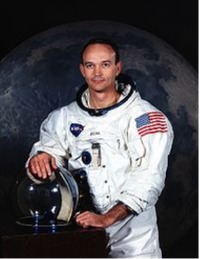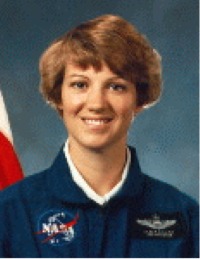The coming of winter and the lengthening nights have always been times where people have traditionally consider their place in the universe. Certainly this was true of the ancient Celts who built the oldest known observatory on the banks of the Boyne at Newgrange where for over 5,000 years the sunrise on the day of the winter solstice floods the normally darkened inner chamber with light. In our own Christian tradition, the three Magi followed a star to pay homage to our Savior, giving rise to our cherished Christmas traditions. Given these roots, it should therefore not be surprising that Irish Americans have played an important role in the exploration of space. In particular two Irish Americans named Collins (though no relations): Brigadier General Michael Collins and Colonel Eileen Collins.

Collins became an expert pilot being one of an elite group of test pilots and was eventually selected for Astronaut training. Collins would first enter space as part of the two man crew of Gemini 10. As part of the mission, Collins performed two space walks as well as docking several times with a target drone, vital preliminaries to the upcoming efforts to put a man on the moon. During one Space walk Collins described the experience as “like a Roman god riding the skies in his chariot.” The less romantic NASA administration gave Collins an additional $24 in “travel money” for the three day mission.
Collins is of course best remembered as a member of the 3 man crew of Apollo 11, the first mission to put a man on the moon. It was actually Collins who designed the mission’s famous logo of an eagle landing on the moon with the earth in the background. Unfortunately, Collins expertise as a pilot meant that he was chosen to be the Command Module Pilot and circled in orbit alone while Neil Armstrong and Buzz Aldrin actually landed on the moon and would walk on its surface. Because of this, Collins is not as well remembered as his fellow Apollo 11 crewmates, but it should be remembered that only through Collins successfully piloting the Command Module to a link up with a passive Lunar Module were Armstrong and Aldrin able to return home and bring a successful conclusion to mans first steps beyond the Earth.

Collins was selected for the Astronaut program in 1990. She was the first woman to pilot a Shuttle in 1995 in the first joint American/Russian Mission to the Mir Space Station. She would pilot a subsequent mission to the Mir before her third shuttle flight where she was commander. In recognition of this special moment, Collins carried a scarf that had once belonged to aviation pioneer Amelia Earhart. In her fourth and final Shuttle Mission, Eileen Collins would be the first pilot to take the shuttle through a 360 degree pitch maneuver to ensure that the shuttle had not incurred damage during launch.
Col. Collins is an active Catholic and she credits her faith as being a major influence in her remarkable career, “I believe God gives us hopes and dreams, the dreams to do certain things with our lives and the ability to set goals.” As we enter the Christmas Season and the dawning of a New Year, certainly these are words , along with the examples of dedication and accomplishment from these two great Irish Americans, to inspire us all to “reach for the stars” in our own lives.
Did You Know That
- The first American Woman to walk in space was Irish American Kathryn Sullivan
- Sharon Christa (nee Corrigan) McAuliffe was the first educator to fly in space and sadly one of the victims of the Challenger disaster.
- After his career in space, Michael Collins fittingly became the first director of the Smithsonian’s new National Air and Space Museum and oversaw it’s construction and development. Eventually Collins was appointed as an undersecretary of the Smithsonian Institution, retiring in 1980. In 1991, Irish American Heritage Month was first proclaimed nationally. Ironically, given Michael Collins tremendous legacy to that institution, the Smithsonian, while actively celebrating and recognizing several ethnic Heritage Months yearly and the specific contribution of several ethnicities, still refuses to recognize March as Irish American Heritage nearly twenty years after its inception.
- The Irish Revolutionary Robert Emmet actually developed a practical rocket artillery as a secret weapon for use during his 1803 Rebellion. Captured prototypes were studied by British Officer. William Congreve, who later claimed credit for Emmet’s design. The plagiarized “Congreve rocket” was used by the British against Fort McHenry, providing “the rockets’ red glare”.
